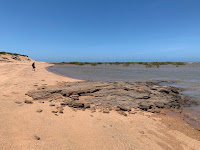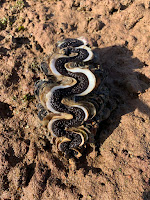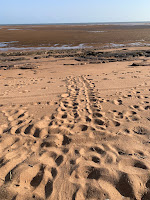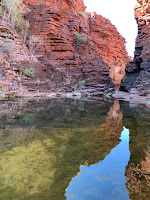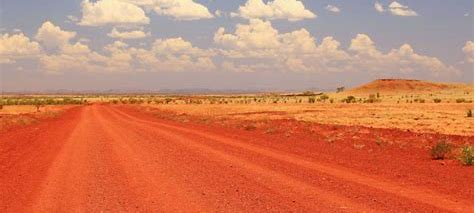There are dangers around of course, and it’s good to put them into a mind-context that doesn’t restrict our activities too much. Not something I thought would be possible when I first investigated all the Aussie critters that can kill you. We have yet to see any huge spiders or venomous land snakes. We know they’re there but probably avoiding us. We see crocodile warning signs most walks, but aware that there haven’t been any actual sightings for months. There are huge ants that bite when you upset them, crabs that raise their claws in defence (quite cute really - a bit like ‘gimme a hug’) and octopi that squirt ink or sea water when you get too close. The sun needs to be considered too. Its heat can be disguised by a bit of sea breeze, and I have noticed that sometimes there aren’t even any mad dogs joining me for beach walks in the middle of the day.
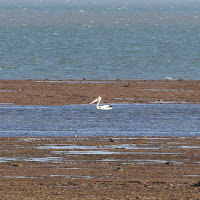
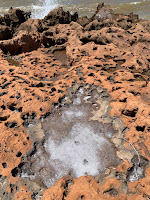
 We've done a few more guided reef walks and continue to marvel at the corals, sponges, fish, crabs, nudibranchs and everything else. Sea birds are equally spectacular – huge pelicans, ospreys, ibis, oyster catchers (pied and sooty), Pacific Reef Heron, Great Egret, dotterel, sand-pipers, Brahminy Kites and various terns. We’ve invented a game called ‘Octopus Soccer’ in which each octopus sighting is a ‘goal’ and if we have to go into extra time, we use the ‘Golden Octopus’ rule. You’ll probably have to take my word that it’s a fun and engaging activity. The reefs are not the same everywhere – sometimes they’re like thick rock slabs, or spiky oyster-encrusted mounds, or creviced deeply or shallowly. Those that are covered by sea water only at high high-tides have thick salt deposits. The sand everywhere is beautifully carved by the sea, creating a stunning myriad of ever-changing curvy patterns. There are shells of all shapes and sizes, most of them uncollectable as they’re occupied and usually in motion. We’ve witnessed several female Flat Backed Turtles crawl up the beach and lay their eggs – truly an unmissable sight. Though we’ve been out a few times in the early morning, we have yet to see any hatchlings emerge. Visible tiny tracks indicate that it’s worth persisting, and luckily the season lasts until March.
We've done a few more guided reef walks and continue to marvel at the corals, sponges, fish, crabs, nudibranchs and everything else. Sea birds are equally spectacular – huge pelicans, ospreys, ibis, oyster catchers (pied and sooty), Pacific Reef Heron, Great Egret, dotterel, sand-pipers, Brahminy Kites and various terns. We’ve invented a game called ‘Octopus Soccer’ in which each octopus sighting is a ‘goal’ and if we have to go into extra time, we use the ‘Golden Octopus’ rule. You’ll probably have to take my word that it’s a fun and engaging activity. The reefs are not the same everywhere – sometimes they’re like thick rock slabs, or spiky oyster-encrusted mounds, or creviced deeply or shallowly. Those that are covered by sea water only at high high-tides have thick salt deposits. The sand everywhere is beautifully carved by the sea, creating a stunning myriad of ever-changing curvy patterns. There are shells of all shapes and sizes, most of them uncollectable as they’re occupied and usually in motion. We’ve witnessed several female Flat Backed Turtles crawl up the beach and lay their eggs – truly an unmissable sight. Though we’ve been out a few times in the early morning, we have yet to see any hatchlings emerge. Visible tiny tracks indicate that it’s worth persisting, and luckily the season lasts until March.
 Peter goes fishing a few times a week (life’s not so hard for him either!) and his catching rate is starting to improve now that he's worked out better strategies. We’ve had fish for dinner several times – Golden and Brassy Trevally (including the one in the photo), Carpet Shark, Remora. All pan fried and served with chips. Swimming in the ocean less than an hour before - can’t get fresher or better than that.
Peter goes fishing a few times a week (life’s not so hard for him either!) and his catching rate is starting to improve now that he's worked out better strategies. We’ve had fish for dinner several times – Golden and Brassy Trevally (including the one in the photo), Carpet Shark, Remora. All pan fried and served with chips. Swimming in the ocean less than an hour before - can’t get fresher or better than that.
 The local swimming pool (Gratwick) is far and away the best pool ever. Overlooking the Indian Ocean, sun-warmed and with Olympic length (50m) lanes, it's totally a pleasure to swim in. So far I've had my own lane every swim, and that's 3-4 times a week. Occasionally I've had the whole pool to myself - not too many wanting to swim at 6:30am! I'm often joined in my post-swim showers by various insects and critters - ants, crickets, flying bugs and tiny geckos - we're all happy to share.
The local swimming pool (Gratwick) is far and away the best pool ever. Overlooking the Indian Ocean, sun-warmed and with Olympic length (50m) lanes, it's totally a pleasure to swim in. So far I've had my own lane every swim, and that's 3-4 times a week. Occasionally I've had the whole pool to myself - not too many wanting to swim at 6:30am! I'm often joined in my post-swim showers by various insects and critters - ants, crickets, flying bugs and tiny geckos - we're all happy to share.
 There are nesting ospreys on our apartment roof, and we have a 'pet' Osprey called Sharon (as in wife of Ozzy) who poses in the same place on our balcony every now and then. One memorable time she stayed all evening and into the night, still perched there at 3:30am. The photo shows her at dusk, with fruit bats in the background.
There are nesting ospreys on our apartment roof, and we have a 'pet' Osprey called Sharon (as in wife of Ozzy) who poses in the same place on our balcony every now and then. One memorable time she stayed all evening and into the night, still perched there at 3:30am. The photo shows her at dusk, with fruit bats in the background.
 We haven't been very social yet, but this may change when the weather permits any kind of lingering outdoors. We have been to a couple of community events - the Christmas Market and an outdoor movie (Home Alone 2 - not our choice and surrounded by kids, but an experience nonetheless). We're getting very adept at the 'Australian Wave' and can totally resonate with the cork hat concept. We do have head insect nets, but need to work on actually remembering them. Getting to the beach can be a whole body exercise - frantic legs and waggly arms - though it's mostly fine at the water's edge when the breeze keeps those dastardly flies at bay. There don't tend to be lots of them at a time like sandflies, but each and every one is a persistent kamikaze, aiming into your mouth and up your nose and ears.
We haven't been very social yet, but this may change when the weather permits any kind of lingering outdoors. We have been to a couple of community events - the Christmas Market and an outdoor movie (Home Alone 2 - not our choice and surrounded by kids, but an experience nonetheless). We're getting very adept at the 'Australian Wave' and can totally resonate with the cork hat concept. We do have head insect nets, but need to work on actually remembering them. Getting to the beach can be a whole body exercise - frantic legs and waggly arms - though it's mostly fine at the water's edge when the breeze keeps those dastardly flies at bay. There don't tend to be lots of them at a time like sandflies, but each and every one is a persistent kamikaze, aiming into your mouth and up your nose and ears.
We've finally managed to get WA driving licences. The admin and red tape to get anything like this in Aus is extensive. You need to provide 5 points of evidence, including specific documents that link you to a residential address. It was easier for me because I'm employed and have a tenancy agreement with my employer, but I still had to open a bank account to be able to provide enough evidence. I chose BankWest because there is a local branch in Port Hedland and it amuses me to think about how BankWest could be articulated by Trevor MacDonald (will he ever live down the Kent Countryside??). Our car was registered in Peter's name and that gave him just enough evidence for his licence. He really didn't want to fall down at the eyesight test hurdle after all that, so got his vision checked and now has corrective glasses that he's supposed to wear when driving. Now that we have our licences, any other permit-type things should be much more simple.
I was expecting to work clinically over Christmas, but despite an ever-changing roster, I somehow managed to get 4 days off. We booked ourselves into a little chalet at the Aspen Village in Karratha. Christmas Eve was spent in and around Point Samson. We visited the small historic settlement of Cossack, Peter fished (his legs providing a banquet for local bitey insects), I tried out my new mask and snorkel at Honeymoon Cove, and we had a huge and delish seafood basket n chip lunch, washed down by our new fave beer - Swan Draught - at the Samson Beach Tavern. There are worse places to be.
On Christmas Day we caught up with the 'boys' by phone and then headed out to the Murujuga National Park (Burrup Peninsula). Our first stop was the sacred Ngajarli Gorge to see the petroglyphs - traditional rock art engravings. The area is thought to have the highest concentration of rock engravings of any known site in the world. They are estimated to be as old as 40,000 years. We were the only visitors in this beautifully serene place, and it was very much a fascinating experience. The first image shows a fat-tailed kangaroo (now extinct). The second shows marni (motifs) - traditional tribal brandings, painted around the base of a man's neck with ochre to identify which group the wearer comes from.


 Christmas Dinner was a picnic at nearby Hearson's Cove. The stunning little beach was a popular Christmas Day destination, with many families and groups enjoying the shell beach and the warm, shallow Indian Ocean. Even 4 horses were led into the sea for a splash. I had another snorkeling stint which was distracting enough to leave me with a totally sunburnt back. Oops.
Christmas Dinner was a picnic at nearby Hearson's Cove. The stunning little beach was a popular Christmas Day destination, with many families and groups enjoying the shell beach and the warm, shallow Indian Ocean. Even 4 horses were led into the sea for a splash. I had another snorkeling stint which was distracting enough to leave me with a totally sunburnt back. Oops.
It's been a Christmas out of the box for us, and kinda good to know that we have no idea what Christmas 2024 will look like. No need to make any plans for that yet. In the meantime, we can carry on enjoying what this part of the world has to offer

